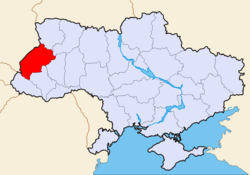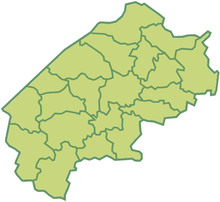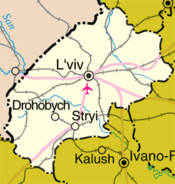- Lviv Oblast
-
Lviv Oblast
Львівська область
L’vivs’ka oblast’— Oblast — 
Flag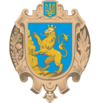
Coat of armsNickname(s): Львівщина (Lvivshchyna) Location of Lviv Oblast (red) within Ukraine (blue) Country  Ukraine
UkraineAdmin. center Lviv Government – Governor Mykhailo Kostiuk[1] – Oblast council – Chairperson Myroslav Senyk[2] (OU) Area – Total 21,833 km2 (8,429.8 sq mi) Area rank Ranked 17th Population (2009[3]) – Total 2,552,900 – Density 116.9/km2 (302.8/sq mi) Time zone EET (UTC+2) – Summer (DST) EEST (UTC+3) Area code +380-32 ISO 3166 code UA-46 Raions 20 Cities of oblast subordinance 9 Cities (total) 44 Towns 34 Villages 1849 FIPS 10-4 UP15 Website www.loda.gov.ua Lviv Oblast (Ukrainian: Львівська область, translit. L’vivs’ka oblast’; also referred to as L’vivshchina – Ukrainian: Львівщина) is an oblast (province) in western Ukraine. The administrative center of the oblast is the city of Lviv.
Contents
History
The oblast was created as part of the Ukrainian Soviet Socialist Republic on December 4, 1939. The territory of the former Drohobych Oblast was incorporated into the Lviv Oblast in 1959.
The oblast's strategic position at the heart of central Europe and as the gateway to the Carpathians has caused it to change hands many times over the centuries. It was ruled variously by Great Moravia, Kievan Rus', Poland and by one of Kievan Rus' successors, the state of Galicia-Volhynia (circa 1200 to 1340), then by the Polish-Lithuanian Commonwealth (1340 to 1772), the Austro-Hungarian Empire (1772 to 1918), and Poland (1918 to 1939), when it was part of the Lwów Voivodship of the Second Republic of Poland. The region's historically dominant Ukrainian population declared the area to be a part of an independent West Ukrainian National Republic in 1918, but this endured only briefly. Local autonomy was provided in international treaties but later on those were not honoured by the Polish government and the area experienced much ethnic tension between the Polish and Ukrainian population.
The region and its capital city take their name from the time of Galicia-Volhynia, when Daniel of Galicia, the King of Rus' founded Lviv, naming the city after his son, Leo. During this time, the general region around Lviv was known as Red Ruthenia (Cherven' Rus').
The region only became part of the Soviet Union under the terms of the Molotov-Ribbentrop Pact in 1939, when it was annexed to the Ukrainian SSR. It was occupied by Nazi Germany from 1941 to 1944 and remained in Soviet hands after World War II as was arranged during the Teheran and Yalta conferences. Given its historical development, Lviv Oblast is one of the least Russified and Sovietized parts of Ukraine, with much of its Habsburg heritage still visible today.
Geography
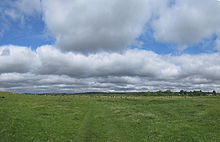 Grassy flatlands with rolling hills in Drohobych Raion
Grassy flatlands with rolling hills in Drohobych Raion
The terrain of Lviv Oblast is highly varied. The southern part is occupied by the low Beskyd (ukr: Бескиди) mountain chains running parallel to each other from northwest to southeast and covered with secondary coniferous forests as part of the Eastern Carpathians; the highest point is Pikuy (1408 m). North from there are the wide upper Dniester river valley and much smaller upper San River valley. These rivers have flat bottoms covered with alluvial deposits, and are susceptible to floods. Between these valleys and Beskyd lies the Precarpathian upland covered with deciduous forests, with well-known mineral spa resorts (see Truskavets, Morshyn). It's also the area of one of the earliest industrial petroleum and gas extraction. These deposits are all but depleted by now.
In the central part of the region lie Roztocze, Opillia, and part of the Podolia uplands. Rich sulphur deposits were mined here during the Soviet era. Roztocze is densely forested, while Opillia and Podolia (being covered with loess on which fertile soils develop) are densely populated and mostly covered by arable land. In the central-north part of the region lies the Small Polesia lowland, geographically isolated from the rest of Polesia but with similar terrain and landscapes (flat plains with sandy fluvioglacial deposits and pine forests). The far North of the region lies on the Volhynia upland, which is also covered with loess; coal is mined in this area.
Climate
The climate of Lviv Oblast is moderately cool and humid. The average January temperatures range from −7 °C (19 °F) in the Carpathians to −3 °C (27 °F) in the Dniester and San River valleys while in July the average temperatures are from 14–15 °C (57–59 °F) in the Carpathians to 16–17 °C (61–63 °F) in Roztocze and 19 °C (66 °F) in the lower part of the Dniester valley.[4] The average annual precipitation is 600–650 mm (23.62–25.59 in) in the lowlands, 650–750 mm (25.59–29.53 in) in the highlands and up to 1,000 mm (39.37 in) in the Carpathians, with the majority of precipitation occurring in summer. Prolonged droughts are uncommon, while strong rainfalls can cause floods in river valleys. Severe winds during storms can also cause damage, especially in the highlands. The climate is favourable for the cultivation of sugar beets, winter wheat, flax, rye, cabbage, apples, and for dairy farming. It is still too cold to successfully cultivate maize, sunflower, grapes, melon, watermelon or peaches in Lviv Oblast. In the Carpathians conditions are favourable for Alpine skiing 3–4 months a year.
Politics
Governors
- Chairmen of the Executive Committee
Term start Term end Name Year of birth Year of death March 1991 6 April 1992 Vyacheslav Chornovil b. 1937 d. 1999 June 1994 July 1995 Mykola Horyn b. 1945 - Representative of the President
Term start Term end Name Year of birth 20 March 1992 June 1994 Stepan Davymuka (s.a.) - Heads of the Administration[5]
Term start Term end Name Year of birth Year of death 7 July 1995 6 Feb. 1997 Mykola Horyn (s.a.) 6 Feb. 1997 14 Jan. 1999 Mykhailo Hladiy b. 1952 15 Jan. 1999 19 March 2001 Stepan Senchuk b. 1955 d. 2005 26 March 2001 26 April 2002 Mykhailo Hladiy b. 1952 26 April 2002 4 June 2003 Myron Yankiv b. 1951 9 June 2003 20 Dec. 2004 Oleksandr Sendeha b. 1953 20 Dec. 2004 4 Feb. 2005 Bohdan Matolych (acting) b. 1955 4 Feb. 2005 20 Feb. 2008 Petro Oliynyk b. 1957 20 Feb. 2008 27 Feb. 2008 Valery Pyatak (acting) b. 1959 27 Feb. 2008 20 April 2010? Kmit Mykola
(acting to 1 Sep 2008)b. 1966 20 April 2010 21 December 2010[1] Vasyl Horbal[6] (s.a.) 21 December 2010 2 November 2011[1] Mykhailo Tsymbaliuk[1] (s.a.) 2 November 2011[1] Current Mykhailo Kostiuk[1] (s.a.) Subdivisions
The Lviv Oblast is administratively subdivided into 20 raions (districts), as well as 9 city (municipalities) which are directly subordinate to the oblast government: Boryslav, Chervonohrad, Drohobych, Morshyn, Novyi Rozdil, Sambir, Stryi, Truskavets, and the administrative center of the oblast, Lviv.
Raions of the Lviv Oblast In English In Ukrainian Administrative Center Brody Raion Бродівський район
Brodivs'kyi raionBrody
(City)Busk Raion Буський район
Bus'kyi raionBusk
(City)Drohobych Raion Дрогобицький район
Drohobyts'kyi raionDrohobych
(City)Horodok Raion Городоцький район
Horodots'kyi raionHorodok
(City)Kamianka-Buzka Raion Кам'янка-Бузький район
Kamyanka-Buz'kyi raionKamianka-Buzka
(City)Mostyska Raion Мостиський район
Mostys'kyi raionMostyska
(City)Mykolaiv Raion Миколаївський район
Mykolayivs'kyi raionMykolaiv
(City)Peremyshliany Raion Перемишлянський район
Peremyshlians'kyi raionPeremyshliany
(City)Pustomyty Raion Пустомитівський район
Pustomytivs'kyi raionPustomyty
(City)Radekhiv Raion Радехівський район
Radekhivs'kyi raionRadekhiv
(City)Sambir Raion Самбірський район
Sambirs'kyi raionSambir
(City)Skole Raion Сколівський район
Skolivs'kyi raionSkole
(City)Sokal Raion Сокальський район
Sokal's'kyi raionSokal
(City)Starosambirskyi Raion Старосамбірський район
Starosambirs'kyi raionStaryi Sambir
(City)Stryiskyi Raion Стрийський район
Stryis'kyi raionStryi
(City)Turkivskyi Raion Турківський район
Turkivs'kyi raionTurka
(City)Yavorivskyi Raion Яворівський район
Yavorivs'kyi raionYavoriv
(City)Zhovkivskyi Raion Жовківський район
Zhovkivs'kyi raionZhovkva
(City)Zhydachivskyi Raion Жидачівський район
Zhydachivs'kyi raionZhydachiv
(City)Zolochivskyi Raion Золочівський район
Zolochivs'kyi raionZolochiv
(City)Demographics
- Male/female ratio: 48%/52%
- Nationalities: 94.8% of region's population are Ukrainians; 92,600 people are Russians (3.6%); Poles account for 0.7%; there are also smaller German, Jewish, and Gypsy minorities.[1]
Religion
Fifty-six percent of the religious organisations active in the Lviv Oblast adhere to the Ukrainian Greek Catholic Church. The Ukrainian Autocephalous Orthodox Church is the second largest religious body. The followers of the Roman Catholic Church and the Ukrainian Orthodox Church (Moscow Patriarchate) are mostly from the Polish, and Russian or non-Galician Ukrainian minorities respectively.
Historical and Cultural Sites
The city of Lviv contains a well-preserved main square (Rynok) and numerous historical and beautiful churches. Other sites of interest are the historic Lychakivskiy Cemetery, the local museum of folklore, and the ruins of the famous Vysokyi Zamok. The name of the castle is tightly tied with the name of the city. There is also a museum of military artifacts, the "Arsenal".
Well-preserved local wooden churches, castles, and monasteries can be found throughout the Oblast. One of them is the Olesko Castle which is first remembered in 1327. Another castle that was built at the end of the 15th century is Svirzh Castle in the village of Svirzh, Peremeshliany Raion. One more and no less famous castle is the Pidhirtsi Castle. Its architectural complex consists of the three-story palace, Kostel, and small park. In Roztochia is also located the Krekhivsky monastery in the buch-pine grove at the foot of the Pobiyna mount. The whole complex consists of the Saint Nikola Church, the bell tower, numerous service structures, and defensive walls with towers. Another site worth of mentioning is the Tustan city-fortress which is built in the rock. The site was nominated as the historical and as the natural wonder of Ukraine. There also a nature complex in the valley of the Kamianka river in Skoliv Raion. Another natural wonder of the region is the Kamin-Veleten (Rock-Giant in English) which is located near city of Pidkamin in Brodivskyi Raion. The name of the local city means Under the Rock. A local museum of Ukrainian art and an institution of higher learning (Ivan Franko State University) are also present.
Nomenclature
Most of Ukraine's oblasts are named after their capital cities, officially referred to as "oblast centers" (Ukrainian: обласний центр, translit. oblasnyi tsentr). The name of each oblast is a relative adjective, formed by adding a feminine suffix to the name of respective center city: L'viv is the center of the L'vivs'ka oblast' (Lviv Oblast). Most oblasts are also sometimes referred to in a feminine noun form, following the convention of traditional regional place names, ending with the suffix "-shchyna", as is the case with the Lviv Oblast, Lvivshchyna.
See also: Romanization of UkrainianSee also
- List of Canadian place names of Ukrainian origin – Ukrainian immigrants to Canada brought place names from this oblast with them to Alberta and Saskatchewan.
- Poland’s Lwów Voivodeship (1921–1939)
- Subdivisions of Ukraine
References
- ^ a b c d e f Yanukovych appoints ex-Ukrzaliznytsia head Kostiuk governor of Lviv region, Kyiv Post (2 November 2011)
- ^ Oblast Council website
- ^ "Ukraine Census, Population as of 1st January 2009". State Statistics Committee of Ukraine. http://www.ukrcensus.gov.ua/eng/news/article;891/. Retrieved 2009-06-20.
- ^ WorldClimate.com (Data for L'viv)
- ^ Lviv, worldstatesmen.org
- ^ Horbal appointed Lviv regional governor, Kyiv Post (April 20, 2010)
- Source for statistics used: L'viv Regional State Administration Web Site – accessed February 29, 2004.
External links
 Media related to Lviv Oblast at Wikimedia Commons
Media related to Lviv Oblast at Wikimedia Commons
 Poland
Poland
Lublin VoivodeshipVolyn Oblast Rivne Oblast 
 Poland
Poland
Podkarpackie Voivodeship
Ternopil Oblast  Lviv
Lviv 

Zakarpattia Oblast Zakarpattia Oblast / Ivano-Frankivsk Oblast Ivano-Frankivsk Oblast Administrative divisions of Lviv Oblast, Ukraine Raions 

Cities Belz · Bibrka · Boryslav · Brody · Busk · Chervonohrad · Dobromyl · Drohobych · Dubliany · Hlyniany · Horodok · Kamianka-Buzka · Khodoriv · Khyriv · Komarno · Lviv · Morshyn · Mostyska · Mykolaiv · Novoiavorivsk · Novyi Kalyniv · Novyi Rozdil · Peremyshliany · Pustomyty · Radekhiv · Rava-Ruska · Rudky · Sambir · Skole · Sokal · Sosnivka · Staryi Sambir · Stebnyk · Stryi · Sudova Vyshnia · Truskavets · Turka · Uhniv · Velyki Mosty · Vynnyky · Yavoriv · Zhovkva · Zhydachiv · ZolochivUrban-type
settlementsVillages  Administrative divisions of Ukraine
Administrative divisions of UkraineOblasts Cherkasy · Chernihiv · Chernivtsi · Dnipropetrovsk · Donetsk · Ivano-Frankivsk · Kharkiv · Kherson · Khmelnytskyi · Kiev · Kirovohrad · Luhansk · Lviv · Mykolaiv · Odessa · Poltava · Rivne · Sumy · Ternopil · Vinnytsia · Volyn · Zakarpattia · Zaporizhia · ZhytomyrCities with special status Autonomous Republic Administrative centers Cherkasy · Chernihiv · Chernivtsi · Dnipropetrovsk · Donetsk · Ivano-Frankivsk · Kharkiv · Kherson · Khmelnytskyi · Kiev · Kirovohrad · Luhansk · Lutsk · Lviv · Mykolaiv · Odessa · Poltava · Rivne · Sevastopol · Simferopol · Sumy · Ternopil · Uzhhorod · Vinnytsia · Zaporizhia · ZhytomyrCategories:- Lviv Oblast
- Oblasts of Ukraine
- Galicia (Eastern Europe)
- States and territories established in 1939
Wikimedia Foundation. 2010.

